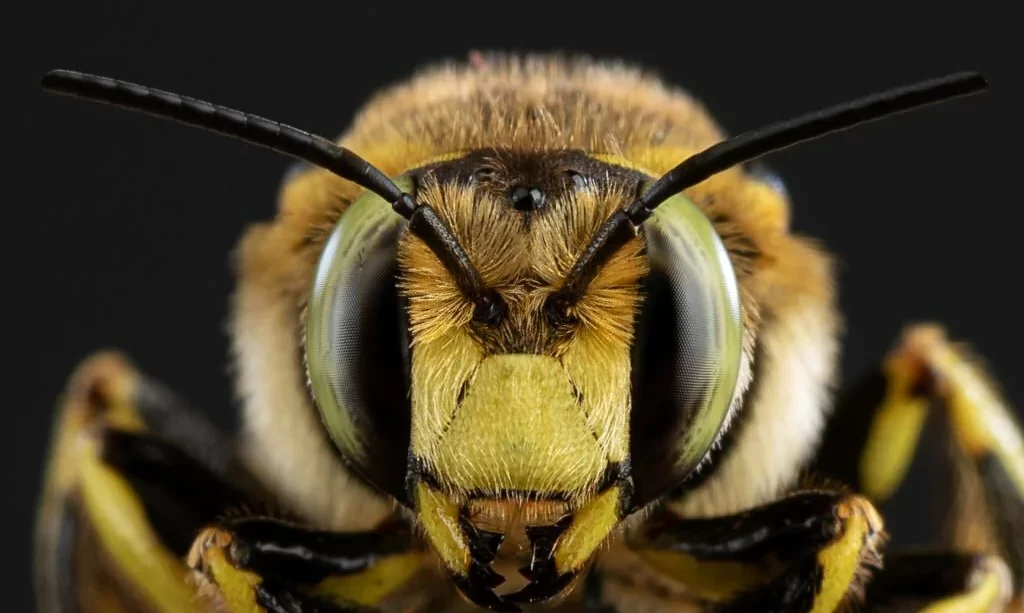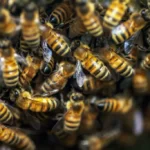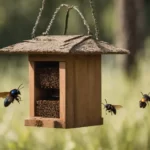In the bustling world of pollinators, where flowers and plants depend on the meticulous work of small winged creatures, bees reign supreme. These remarkable insects, known for their vital role in pollination, are not only proficient flyers but also possess an extraordinary sense of vision. How does a bee see the world, and what secrets lie within the facets of their multifaceted eyes? To truly appreciate the intricate relationship between bees and the flowers they visit, we must delve into the captivating realm of bee vision.
As we journey through this article, we will uncover the unique attributes of bee vision, from their complex compound eyes to their ability to see a spectrum of colors that rivals our own. Bees, with their impressive visual senses, navigate the world in ways that both baffle and amaze, influencing the survival of countless plant species. Let’s embark on this journey to understand how bees perceive the world around them.
The Anatomy of Bee Eyes
To comprehend the intricacies of bee vision, we must first explore the marvel of bee eyes. Unlike humans, who possess single, simple lenses in each eye, bees are equipped with large, compound eyes that are composed of thousands of tiny lenses known as ommatidia. Each ommatidium captures a small portion of the visual field, contributing to the overall mosaic image seen by the bee.
The arrangement of these ommatidia across the surface of the bee’s eye creates a unique panoramic view of their surroundings. This compound eye structure provides bees with the ability to detect even the slightest of movements, making them highly attuned to changes in their environment.
Types of Bee Vision
Bees view the world through a unique lens, quite literally. Their vision differs from that of humans in several remarkable ways. One of the most intriguing aspects of bee vision is their ability to perceive ultraviolet (UV) light. Bees can see ultraviolet light, which falls outside the visible spectrum for humans. This exceptional trait allows them to detect intricate patterns on flowers that are invisible to us. To a bee, a flower’s “landing strip” is painted with UV markings, guiding them to the nectar and pollen they seek.
But bee vision doesn’t stop at UV light; these industrious insects also possess color vision. While humans have three color receptors (red, green, and blue), bees have just three color receptors as well, but they are tuned to different wavelengths. Bees see colors in the blue and ultraviolet part of the spectrum, making them sensitive to blues, violets, and certain shades of yellow and green.
This unique spectrum of color vision in bees allows them to distinguish between various flower colors and patterns, aiding them in efficient foraging and pollination. The ability to perceive colors beyond our range of vision is a testament to the fascinating world of bee vision, where every petal and pattern tells a story known only to them.
Polarized Light Detection
Beyond their remarkable abilities to see UV light and distinguish colors, bees possess another extraordinary visual talent – the detection of polarized light. Polarized light refers to light waves that vibrate in a specific direction, creating patterns of light polarization. While humans are generally insensitive to polarized light, bees have adapted to utilize this phenomenon for various purposes.
Polarized light detection plays a crucial role in the bee world, particularly in navigation. Bees can detect polarized light patterns in the sky, allowing them to determine the position of the sun even on cloudy days when the sun itself may be obscured. This helps bees maintain their sense of direction and time, an essential aspect of their intricate foraging journeys.
The ability to detect polarized light also aids bees in distinguishing between various objects, such as water sources and the reflective surfaces of leaves. It assists them in making informed choices during their foraging expeditions and ensures they return safely to the hive with the precious resources they’ve gathered. The use of polarized light detection is yet another example of the remarkable adaptations that bees have developed to navigate their complex environment.
Bee Navigation and the Waggle Dance
Bee navigation is a feat of precision and communication, guided by their exceptional visual abilities. The most famous expression of bee navigation is the “waggle dance,” a complex series of movements performed by forager bees to communicate the location of a promising food source to their hive mates.
Bees that have discovered a bountiful source of nectar or pollen return to the hive and, through the waggle dance, provide precise instructions to others. This dance includes a “waggle run” in a figure-eight pattern and a specific “waggle phase” during which the bee vibrates its body. The angle and duration of the waggle phase convey information about the direction and distance to the food source.
Remarkably, the waggle dance is influenced by the sun’s position in the sky, and bees adjust their dance accordingly. By interpreting the information in the dance and using their polarized light detection capabilities, hive mates can determine the direction and distance to the food source, allowing them to fly directly to the location described in the dance.
This intricate form of communication and navigation is a testament to the sophistication of bee colonies, where each individual’s contribution is integral to the success of the whole hive. Bee vision, with its keen perception of polarized light and understanding of the sun’s position, plays a pivotal role in orchestrating these aerial choreographies.
The Role of Bee Vision in Flower Foraging
Bees are meticulous flower foragers, and their visual acumen is a cornerstone of their success in pollination and resource gathering. The role of bee vision in flower foraging is multi-faceted and crucial to both the bees and the plants they visit.
When a bee approaches a field of blossoms, their UV-sensitive eyes pick up patterns on flower petals that serve as “nectar guides.” These guides are like landing strips for the bees, directing them to the heart of the flower where nectar and pollen are waiting. The combination of UV vision and color perception helps bees differentiate between flower species and recognize the ones with the most abundant rewards.
The precision of bee vision is essential for efficient foraging, allowing bees to make quick decisions about which flowers to visit and where to find the most nutritious resources. In return for their diligent work, bees play a pivotal role in the pollination of countless plant species, contributing to the reproduction of flowers and the production of fruits and seeds. The intricate relationship between bee vision and flower foraging is an exquisite dance of coevolution, where each partner has adapted to the other’s cues and signals in a harmonious exchange of life and sustenance.
Challenges and Adaptations in Bee Vision
While bees’ visual abilities are extraordinary, they face numerous challenges in their daily lives. One of the primary challenges is the dim light conditions encountered during dusk and dawn, as well as on cloudy days. Bees rely heavily on the sun’s position in the sky for navigation, making these low-light situations potentially disorienting. To overcome this challenge, bees have developed an ingenious adaptation known as “polarized light patterns,” which allows them to continue determining the sun’s location even when it’s not directly visible.
Another challenge arises when bees encounter flowers that are deceptive or mimicry, posing as a food source but providing no nectar or pollen. Bees have adapted to recognize and avoid such deceptive blooms by assessing the flower’s color, pattern, and other visual cues. Their ability to learn and adapt to such challenges is a testament to the flexibility and sophistication of their visual system.
Lastly, bees must also contend with human-made challenges, including the widespread use of pesticides and habitat loss. These factors can negatively impact bee populations and their visual abilities, making it crucial for conservation efforts to protect these essential pollinators and their unique vision.
The Connection Between Bee Vision and Pollination
The connection between bee vision and pollination is one of profound ecological significance. Bees are renowned pollinators, facilitating the reproduction of countless plant species, including many of our agricultural crops. The interplay between bee vision and the floral world is a crucial element in this process.
Bees are uniquely adapted to recognize the visual cues that flowers provide, from their colors to their patterns, and even their UV nectar guides. As bees forage, their precision in recognizing these cues is instrumental in their efficient and targeted pollination. When bees visit flowers to collect nectar and pollen, they inadvertently transfer pollen between the flowers’ male and female reproductive structures, enabling fertilization and the development of seeds and fruits.
The result of this intricate partnership is the growth of fruits, vegetables, and other plants that sustain not only human populations but also countless other species. Bee vision, with its remarkable adaptations and sensory capabilities, underpins the coevolutionary relationship between these pollinators and the flowers they visit.
Conclusion
In the captivating world of bee vision, we find a remarkable tapestry of adaptations, intricacies, and coevolution. These industrious insects navigate their world with precision and grace, thanks to their compound eyes, UV vision, and the ability to detect polarized light. Their ability to perceive the world in ways that elude human senses has made them invaluable partners in the pollination of plants and the production of our food.
As we delve into the secrets of bee vision, we gain a profound appreciation for these small yet mighty creatures and the role they play in the delicate balance of ecosystems. Bees, through their vision, guide us into a deeper understanding of the interdependence of all life on our planet.
The intricate dance between bees and flowers, orchestrated by their exquisite vision, serves as a reminder of the beauty and complexity of the natural world. It underscores the urgent need to protect bee populations and their habitats to ensure the survival of these essential pollinators and the countless species that rely on them for sustenance and biodiversity. As we marvel at the wonders of bee vision, may we also be inspired to take action to safeguard the future of these remarkable insects and the ecosystems they support.



